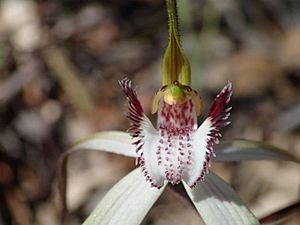Southern white spider orchid facts for kids
Quick facts for kids Southern white spider orchid |
|
|---|---|
 |
|
| Subspecies australora near Esperance | |
| Scientific classification |
|
| Kingdom: | Plantae |
| Clade: | Tracheophytes |
| Clade: | Angiosperms |
| Clade: | Monocots |
| Order: | Asparagales |
| Family: | Orchidaceae |
| Subfamily: | Orchidoideae |
| Tribe: | Diurideae |
| Genus: | Caladenia |
| Species: | |
| Subspecies: |
C. l. subsp. australora
|
| Trinomial name | |
| Caladenia longicauda subsp. australora Hopper & A.P.Br.
|
|
| Synonyms | |
|
Arachnorchis longicauda subsp.australora (Hopper & A.P.Br.) D.L.Jones & M.A.Clem. |
|
The southern white spider orchid (scientific name: Caladenia longicauda subsp. australora) is a special plant. It belongs to the orchid family. This orchid only grows in the south-west part of Western Australia. It has one fuzzy leaf and usually up to three mostly white flowers. These flowers are quite small. You can find this orchid growing in forests and shrublands along the south coast, especially near the Fitzgerald River National Park.
What it Looks Like
The southern white spider orchid is a plant that grows from the ground. It is a perennial plant, meaning it lives for more than two years. It also loses its leaves each year, like some trees. This orchid has a single hairy leaf that is about 6 to 16 centimeters (2.4 to 6.3 inches) long. It is about 0.5 to 1 centimeter (0.2 to 0.4 inches) wide.
The plant grows a stem that is about 15 to 35 centimeters (5.9 to 13.8 inches) tall. On this stem, you can find up to three flowers. These flowers are mostly white and are quite large for an orchid. They measure about 8 to 12 centimeters (3.1 to 4.7 inches) long and 5 to 8 centimeters (2.0 to 3.1 inches) wide.
The parts of the flower that look like petals are called sepals and petals. The side sepals and petals hang down. They have long, thin tips. The top sepal stands straight up. The side sepals are about 0.5 to 0.7 centimeters (0.2 to 0.3 inches) wide. The petals are about 0.3 to 0.4 centimeters (0.1 to 0.2 inches) wide.
The main lip of the flower is called the labellum. It is mostly white and about 1.8 to 2.5 centimeters (0.7 to 1.0 inches) long. The sides of the labellum have long, narrow teeth. In the middle, there are four or more rows of small, pale red bumps. These bumps are called calli. This orchid usually blooms from September to October.
How it Got its Name
The main species, Caladenia longicauda, was first officially described in 1840. This was done by a scientist named John Lindley. He published his description in a book called A Sketch of the Vegetation of the Swan River Colony.
Later, in 2001, two other scientists, Stephen Hopper and Andrew Brown, studied this orchid more closely. They found eleven different types, or subspecies, of Caladenia longicauda. One of these was named subspecies australora. They shared their findings in a scientific journal called Nuytsia.
The name australora comes from two Latin words. "Australis" means "southern," and "ora" means "the coast." This name was chosen because this specific type of orchid grows along the southern coast.
Where it Lives
The southern white spider orchid grows in a specific area of Western Australia. You can find it between the Fitzgerald River National Park and the Beaufort Inlet. This area is part of a larger natural region called the Esperance Plains.
This orchid likes to grow in forests and woodlands. It prefers sandy soil that contains a lot of calcium carbonate. This type of soil is often found near coastal areas.
Protecting the Orchid
Good news! The Western Australian Government's Department of Parks and Wildlife has looked at the southern white spider orchid. They have officially said that it is "not threatened." This means it is not currently in danger of disappearing.

